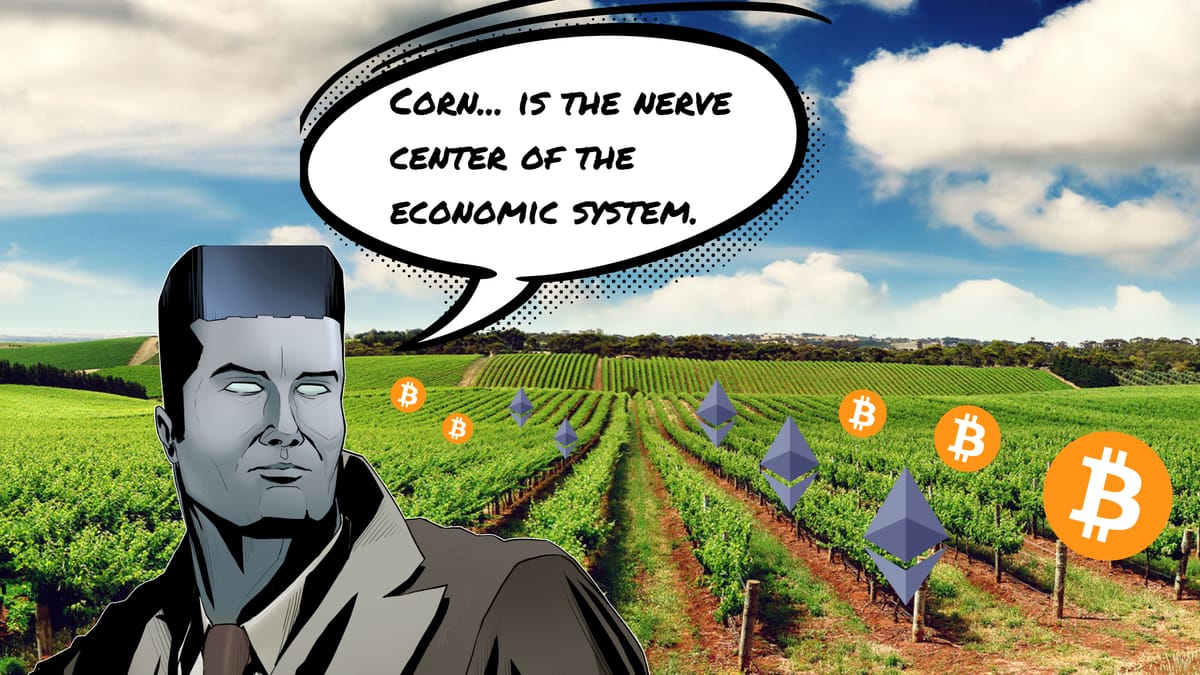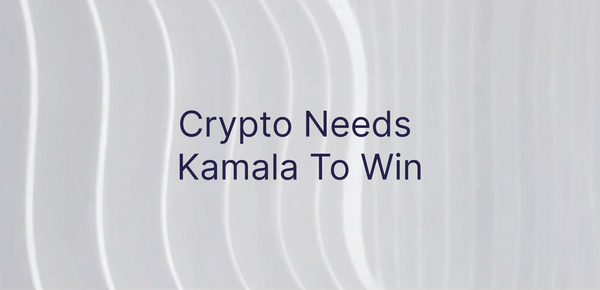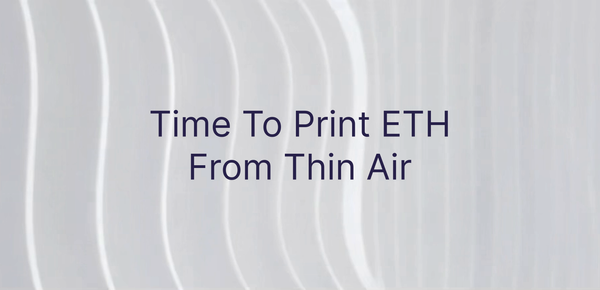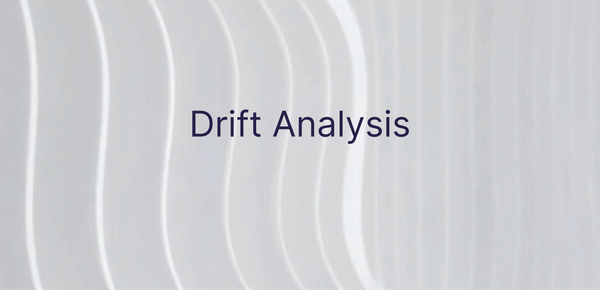What Crypto Can Learn From the Corn Economy
Single Origin: Token Economies Need a New Monetary Policy

We all view them differently.
Talk to somebody climbing the corporate ladder, you’ll hear they trade like stock.
To a media person, they’re a way to reward your most loyal followers.
To an arcade owner, they’re just game credits.
But in a world where regulators can’t agree on what is a token, I’d like to toss my hat in the ring to offer a possible perspective.
My aim is not to release more hot air into the ivory halls of Capitol Hill…
It’s to give potential investors in this arena a better understanding of why a token has value, and how that value can change because of various fundamentals…while also preaching to builders about what they need to focus on in the next iterations of our industry.
To roll this view out, I’d like to lean on a farming analogy. We can use this to define exactly what a token is and how it can fuel an economy. We’ll even get into why government-issued currency is valuable (a controversial topic in crypto circles for sure) and why price stability is arguably the most important factor we need to be spending more time on.
One thought you might have while reading this is, why go through all this discussion? Does it really matter?
In truth, it might not.
But for now, my stance is simple. For the industry to take itself up a level, to mature into something to be embraced rather than scorned, there needs to be a realization. Introducing price stability into a cryptocurrency will unlock higher levels of economic productivity. Not just for Web3, but for the global economy.
In turn, more attention toward price stability will result in a more robust blockchain-based ecosystem that is more equitable, diverse, and resilient than the current Web2-based economy.
OK, that probably sounds rather heavy…
So let’s try not to spend too much time on a soapbox here and tone down on the world peace promises. Instead, let’s get started by lacing up our imaginary boots and climbing into a tractor. It’s time to form our mental model of what drives the value of a token.
Token Farming
You’re a farmer. Don’t close your eyes, because you’ll need to keep reading, but try to imagine it for a moment.
Your crop of choice is corn.
To determine just how much to plant for the year, you break down what the market is willing to pay for an ear of corn.
At $5 a bushel, you figure it comes out to be $0.10/ear of corn (for any farmers out there, these are decent-sized sweet corn with a bit of rounding).
Because you’re a farmer, you often mentally price things in terms of your crops rather than dollars and cents. In fact, you know at these prices the stick of butter you will pick up at the store later costs about 40,000 kernels of corn (800–1,000 kernels per ear gives us $0.0001 per kernel. Butter is $4).
You even daydream about pulling tens of thousands of kernels from your pocket at the register and paying for that stick of greatness. In some ways, this is how you view your land. It quite literally grows money.
And for the blockchain-native folk, we can view blockspace in a similar manner. Each block has scarcity in either storage or computation. But instead of using manual labor to plant seeds, apply fertilizers, and harvest the plants…we use computer resources to validate a block.
Both situations require upfront costs in either seeds, the GPUs, or initial stake of capital. The land is then worked, GPUs are connected, or capital is staked. Then in each situation, the work takes place on the scarce resource – land or blocks.
The analogy doesn’t end there. With the yield being produced as a byproduct of this work, we now have an intrinsic cost.
In the case of land, it’s labor time, seeds, fertilizer, and gasoline for the tractor, among others. With GPUs, it’s the labor in setup, depreciation of the hardware, electricity, and cooling. And stake of capital is server uptime, computation, and depreciation as well.
These costs help us better understand the value of the yield produced. And without taking into consideration subsidies or any other price-manipulating factors, the farmer will sell each kernel of corn for more than it cost to produce on average. Just like with cryptocurrencies, if the input costs don’t cover what the yield fetches on the market, you’re likely to unwind the operation.
In this way, we can begin to view tokens as a yield of the protocol itself. For Bitcoin, BTC is the yield of the network. Ethereum, ETH. Just like each ear of corn is a yield of the land.
Now, we can better understand exactly what influences the prices of the yield coming from either land or blockspace, relative to the scarce resources and inputs.
To keep expanding on this analogy, let’s loop in one of our favorite characters: The “Man of Brrr.”
Airdropped Dollars
When Federal Reserve Chairman Jerome Powell speaks, he often refers to “levers of the economy.”
He did this at length when the pandemic hit in 2020.
During that time, many people were no longer spending. This lack of spending meant people were not using dollars as often as they were. To counteract this economic shock, Powell and company pulled a lever and airdropped dollars without haste, in the form of stimulus checks.
Note: For now, I will avoid getting into economic jargon for now around money supply measurements, velocity, and price levels (P = MV/Q), as I’ve discussed before. I’ll reserve future discussions and likely a video series that dives into this aspect at length. For now, I want to really hone into perceived value here.
Naturally, people began spending these dollars. Since the input to acquire these dollars was very low, they didn’t value each dollar as much as they did prior.
As a result, the economy’s savings rate plummeted…and so did the value of each dollar.
That means your purchasing power has eroded. If a widget only cost $100 in 2020, today that same widget costs $118.
Going back to our kernel discussion, if kernels of corn suddenly began to fall from the sky in mass, the farmer will suddenly have more kernels in their warehouse.
Again, this is just perceived value, not a discussion of supply and demand. And in this discussion, the farmer is now using fewer inputs on average. Which means they are willing to accept less per kernel.
As the farmer’s intrinsic value of kernels changes, the purchasing power of each kernel also changes. No longer does that stick of butter cost 40,000 kernels. Perhaps it’s now 70,000 kernels.
This is inflation in the farmer’s household. But if we zoom out, it’s also inflation in the corn economy.
That’s because corn extends beyond the use case of just picking and eating. Which leads us to the next discussion related to the purchasing power of kernels…
An Economy Built on Kernels
Biodiesel, tortillas, fall decorations, feed for animals…
Corn is a commodity that can be used not just for immediate consumption, but as an input for other things.
In the case of tortillas, somebody might purchase a few ears of corn and then grind the kernels into a flour. They’ll then combine it with a few other ingredients, roll out the dough, and bake it to create tortillas. Then, they’ll sell them for more than the inputs that went into the tortilla.
The tortilla might then be sold to a restaurant that adds in blackened fish, salsa, cabbage, and a dollop of sour cream…which is then sold to you. Again, for more than the inputs that went into producing it.
Welcome to productivity.
This simple chain of activity drills down what economic productivity is all about. Sure, we can all eat kernels of corn to stay alive. But blackened fish tacos are way more delicious.
And since each added step takes that kernel of corn and adds inputs, the output is a higher amount. The result is that it increases the value of each kernel. Meaning by adding various levels of production, each kernel goes from $0.0001 per kernel to maybe two or three times that in terms of economic output.
What has also happened is businesses spring up to produce corn flour and tortillas along with restaurants that sell them. The corn also needs bags to ship it, people to deliver it, and much more.
It even needs financial infrastructure to help facilitate the trade of all the kernels, helping connect sellers and buyers at scale.
This is the corn economy.
Many individuals and businesses are involved in some capacity.
There are refineries to produce biodiesel, flour makers, companies that produce bags or cargo for transportation, firms that provide means of transportation like trains or trucks, silo makers for storage, chemists that manufacture fertilizer for corn, manufacturers of seed planting equipment, harvesters. The list just goes on and on.
And if kernels were non-perishable, we would be able to look at how big the corn economy and all of its businesses are based upon the number of transactions taking place using kernels.
It’s amazing to think just how massive and productive corn really is. There are even insurance companies that offer products to help farmers stay solvent from year to year.
Now, if we go back to the example from earlier, what would happen if kernels of corn suddenly rained down from the sky?
All these industries would feel the impact. And here’s where we can start to bring into the discussion the importance of price stability to an economy…
If kernels continue to rain down from the sky, and the inputs that go into each kernel keep falling, the value of each kernel will collapse. This makes intuitive sense.
However, if events take place, like a disease that impacts kernels around the world, the price of each kernel will go sky high. This is scarcity.
It shocks the corn economy, and as a result, many businesses close their doors. The volatility of kernels makes it harder to pay salaries, maintain margins, and most importantly, grow.
This causes productivity levels to get hammered in the corn economy. And as a result, workers, entrepreneurs, and farmers start to leave in search of less volatility.
Volatility is a bitch. And before I truly drive the point home on why token economies require greater price stability, I’ll hit on one more point that merges this analogy more seamlessly.
Token Economies
To finish off our analogy, we need to tie the corn economy to cryptocurrencies.
To do this, we need to discuss productivity. For the corn economy, it was taking the commodity and creating a use case that fetched a price that was more than the inputs going into the production.
We can see a similar setup when looking at the ways ETH can be used on Ethereum. Some basic examples are paying to complete a wallet-to-wallet transaction, to compute, to store data, or to create a smart contract.
Let’s run with that last one a bit. An individual uses ETH to create smart contracts. From those smart contracts, a business owner builds an application that enables users to store an image. This business owner then sells those images to a game creator who uses those avatars in a game.
All of this requires the usage of ETH, and creates higher use values for the end product. As long as the end result fetches the individual or business more than the inputs, there is productivity taking place.
Right now, a lot of these things look like swap protocols, lending or borrowing applications, and NFT sales. The creators spend ETH to build the necessary applications.
In many instances, these applications receive payment in ETH, pay employees in ETH, and need ETH on their balance sheets to cover input costs that are incurred as a part of day-to-day operations.
This is the ETH economy.
It’s young. And unfortunately…the byproduct of volatility has been that many businesses and applications are closing their doors, employees are leaving, and growth is stalling.
But before we hit on some thoughts on what greater price stability can mean…I’d like to finish up this analogy by bringing into the equation non-perishable money – the way kernels of corn become stores of value.
Thank you for reading Espresso. This post is public so feel free to share it.
Government Money Can Be Good
I know I’m running long here…But a major topic was left untouched. So I’ll make this point rather quickly, and hopefully expand on it at a later date.
That topic is why government-issued money is valuable. This argument goes against the grain of most libertarian maximalists. It also assumes the government’s function is to serve the interests of its citizens, so please don’t conflate this analogy with some modern-day governance examples.
OK, to start, this view begins with the non-perishable aspect of money.
Kernels of corn are a terrible store of value. They rot. Nobody wants to place their wealth in a currency that gets destroyed daily. It would be like your bank charging a penalty for not spending your savings at a certain rate.
Converting kernels into a non-perishable store of value is one solution. Some money nerds might say that you can store it in tobacco leaves, gold, or some other commodity that is non-perishable, but I’d like to offer an alternative.
We just discussed the corn economy at length. At the foundational level, there is land.
That land can grow more than just corn. It can grow an array of other crops. Or even house communities, provide clean water or minerals – there are many other uses.
This results in a highly diverse economy sitting atop of a layer-one – land. The land is organized around a set of laws that define private ownership.
But to enforce this ownership through courts, watchdogs, and administration means those participating in the economy want an impartial organization at the helm. This is the state.
By definition, the state consists “most broadly, of the agreement of the individuals on the means whereby disputes are settled in the form of laws.” In blockchains, this is the “code is law” doctrine that users of the network implicitly agree to when they transact.
Now, to pay for this “work,” the state taxes those taking part in this agreement – in other words, the people within its geographic borders.
One way it charges these taxes is on goods and services purchased within the territory. This is sales tax.
So right here, we have individuals selling their yield, which is in the form of a good or service. This transaction takes place on the “layer-one” that is being secured by various state actors. For those following along on this blockchain analogy, we have a few parallels taking form here.
Gas fees are similar to sales tax. And the layer-one of the state needs to distribute its own currency so the citizens can pay in that form.
It also needs to pay for public goods, so having its own currency helps in this regard…just like the Ethereum Foundation pays for work in its native currency when sponsoring public good projects.
There is another benefit here as well. The currency helps reduce friction between various commodities that are either perishable and non-perishable. Meaning the issued currency makes itself a good store of value.
Money in this regard is a way to pay for the security and common rule set that an individual agrees to while they use the scarce resource (land or blockspace) to be productive.
Meaning for the United States, its dollar is a yield of the land within its borders.
And a group known as central bankers is tasked with maintaining its price stability.
I’ll quickly ask the annoying question here of why those of us in crypto don’t try and focus on price stability in the hope of maximizing usage. Hopefully, we see here that embracing volatility is short-sighted.
Instead, perhaps we will see a change – one where projects embrace the tools of monetary policy. Tools that allow for more dynamic changes to things like supply, with the end goal to maximize productivity.
Pre-programmed emissions might not be the best way to go about it.
For those that disagree, I ask…Would you want to start a business in a country where the currency realizes 80–90% drawdowns to the U.S. dollar? Or one that maintains a higher level of price stability?
I choose the latter. And for those that say pre-programmed emissions are the only way…I’ll quickly add, the economic tool kit includes much more than that. But more on that later.
In the meantime, feel free to tell me I’m wrong on Twitter (@MrBenLilly) or send us some feedback at espresso@jlabsdigital.com.
And for those that are reading this in our new format, I hope you like it. We are now using Sigle.io for our blog and for sending our emails (we’re slowly transitioning over, so if you still see emails coming from Substack, that will change soon).
Alright, that’s enough out of me. More on all of this soon.
Your Pulse on Crypto,
Ben Lilly





